A Walking Tour through Ottawa
Exploring Ottawa by foot reveals the Canadian capital’s rich historical layers, architectural grandeur, and evolving identity. This walking tour weaves through the city’s most iconic sites, offering both visual delight and a sense of national heritage.
🏛️ Parliament Hill – Heart of Canadian Democracy
Standing majestically above the Ottawa River, Parliament Hill is the symbolic and political heart of Canada. It’s not just a seat of government—it’s a national icon that represents the country’s identity, history, and democratic principles. The complex comprises three main buildings arranged in a horseshoe shape, set around a central lawn often used for public events and protests.
🔨 Original construction took place 1859–1876. In 1916, a devastating fire destroyed the original Centre Block, sparing only the Library of Parliament. The new Centre Block was completed in 1927.
The architectural style is Gothic Revival, inspired by the British Parliament, designed to reflect the ideals of democracy, permanence, and grandeur. The Gothic Revival style is marked by Pointed arches, Ornate stone carvings, Copper-clad roofs and Decorative pinnacles and towers
Over time, the buildings have undergone renovations to preserve both form and function, with the largest restoration project in Canadian history currently underway (expected to be completed in the 2030s).
🏛️ Centre Block (currently under restoration) was completed at 1927 by the Architects John A. Pearson and Jean-Omer Marchand. It houses the House of Commons, the Senate, and many administrative offices.
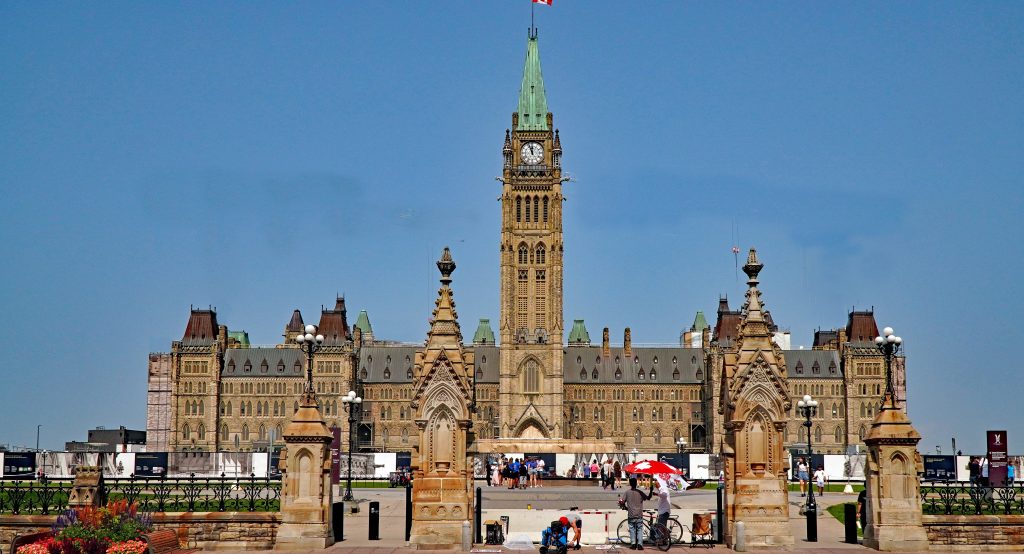
🏰 The exterior is dominated by the Peace Tower (1927), a 92.2-metre-tall bell and clock tower commemorating Canadians who died in WWI. The Statues of historical figures and allegorical stonework adorn the facades.
🏛️ Interior (pre-restoration): The Hall of Honour, a long vaulted corridor of Tyndall limestone, lined with statues and memorials. Gothic ribbed vaults and stained-glass windows honor Canada’s military legacy.
The House of Commons Chamber is decorated in green (a tradition inherited from Westminster). Gothic wood paneling, a public gallery, and ornate carvings representing provinces and industries. The Speaker’s chair is an exact replica of the one in Westminster, London.
The Senate Chamber is decorated in red, reflecting its British roots. It is richly adorned with murals depicting Canada’s history. The throne used by the Governor General during the Speech from the Throne sits at the front.
The Library of Parliament (survived the 1916 fire) was completed in 1876, designed by Thomas Fuller. It is inspired by the Reading Room of the British Museum. The Circular, domed structure with wooden paneling, flying buttresses, and detailed sculptures.


The interior includes a white marble statue of Queen Victoria and thousands of books in wooden alcoves.
🏢 The East Block was built 1859–1865 in Gothic Revival style. Originally, it housed the offices of the Prime Minister and Cabinet ministers.

The interior preserved 19th-century offices, such as those of Sir John A. Macdonald (Canada’s first PM), give visitors a glimpse into early Confederation-era government. It includes gaslight chandeliers, leather-bound desks, and wallpaper accurate to the 1870s.
🏢 The West Block was built in 1859–1865. The ajor rehabilitation was completed in 2019. Temporary it homes the House of Commons during Centre Block renovations.

Interior: The central courtyard was covered with a glass roof to create a modern Commons chamber, combining heritage stonework with cutting-edge technology. The Original Gothic windows, vaulting, and decorative features were carefully preserved or reconstructed.
🌿 The Grounds and Monuments themselves are an open-air museum of Canadian history. There are Statues of Prime Ministers and monarchs (Macdonald, Laurier, Queen Victoria, etc.), The Centennial Flame (lit in 1967 to celebrate Canada’s centennial) and Landscaped gardens, public art, and interpretive plaques
🏛️ In the 19th century, Parliament Hill was chosen for its strategic vantage point and symbolic centrality to the new Dominion of Canada (est. 1867).
Now: It remains the hub of federal legislative activity and a stage for national expression—celebrations like Canada Day, vigils, protests, and public discourse.
2. National War Memorial
A short stroll south leads to the National War Memorial, unveiled in 1939. Designed by Vernon March, this dramatic granite arch is topped with bronze figures representing peace and liberty and features soldiers from various branches below.
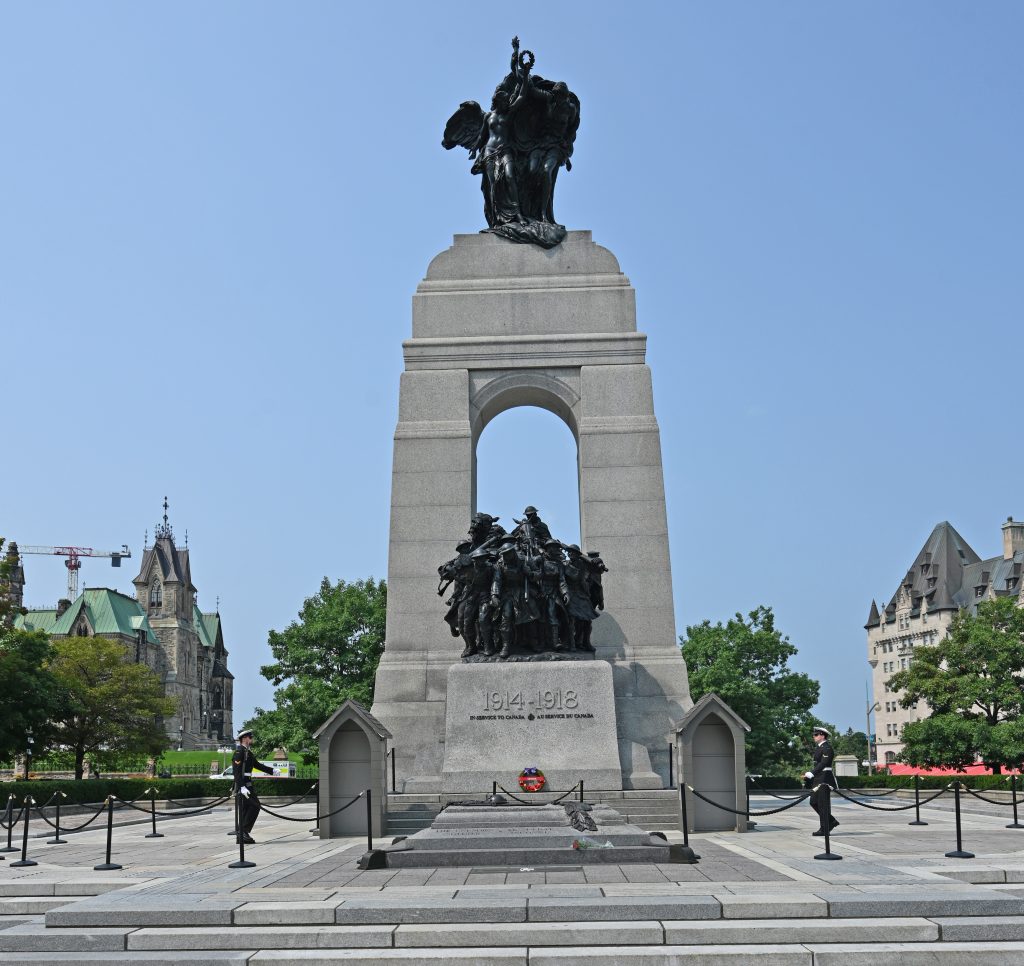
Its style blends Classical and Art Deco influences, symbolizing strength and solemnity. Originally dedicated to WWI dead, its role expanded to include all Canadian conflicts. It remains a focal point for national remembrance, especially on Remembrance Day (November 11).
3. Fairmont Château Laurier
Turning east, the majestic Fairmont Château Laurier dominates the skyline. Opened in 1912, this French Gothic Revival hotel—resembling a Loire Valley château—was commissioned by Charles Melville Hays of the Grand Trunk Railway.

Turrets, dormers, and steeply pitched roofs give it a fairy-tale appearance. Though not part of Parliament Hill, it was intended to harmonize with the Gothic theme of nearby federal buildings. Today, it remains a luxury hotel and a beloved city landmark.
4. Central Chambers Building
Just across the street is the Central Chambers Building, completed in 1893. This ornate structure reflects Queen Anne Revival and Victorian Commercial styles, showcasing red brick with intricate terracotta ornamentation.

Originally used for commercial offices, the building was restored and now houses federal government offices. It’s a fine example of Ottawa’s architectural transition into modern urbanity in the late 19th century.
5. Rideau Canal
Continuing along the Rideau Canal, a UNESCO World Heritage Site, you trace a path with deep historical and engineering significance. Opened in 1832, the canal was built under the supervision of Lieutenant Colonel John By as a military supply route in case of American aggression after the War of 1812.
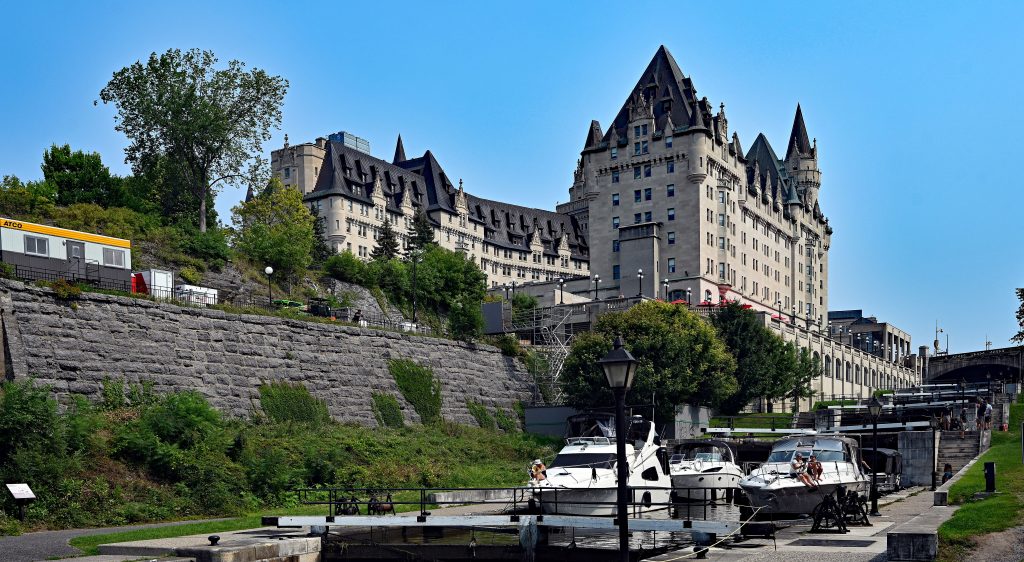
Its military engineering style features manually operated locks still functioning today. In summer, it’s a boating haven; in winter, the frozen canal transforms into the world’s largest skating rink, beloved by locals and tourists alike.
6. National Gallery of Canada
Head north toward the National Gallery of Canada, completed in 1988 and designed by Moshe Safdie. This striking example of Modern architecture features a glass and granite façade, creating an airy and luminous space.
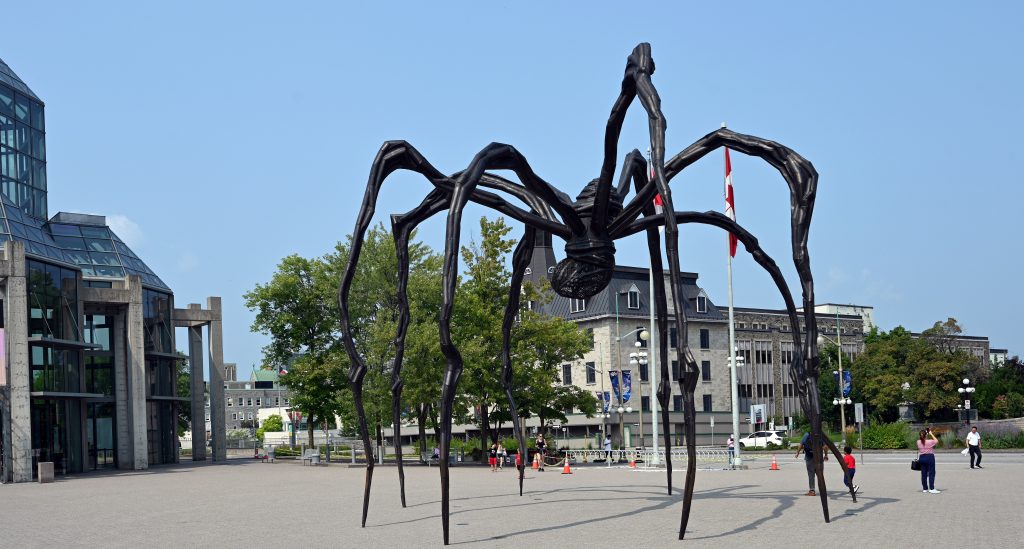
Inside, it houses an extensive collection of Canadian, Indigenous, and international art. Outside stands “Maman”, a giant spider sculpture by Louise Bourgeois—one of Ottawa’s most photographed pieces of public art.
7. Cathédrale Notre-Dame
Right across Sussex Drive stands Cathédrale Notre-Dame d’Ottawa, the city’s oldest and largest church, completed in 1846 and remodeled in 1879 in Gothic Revival style.
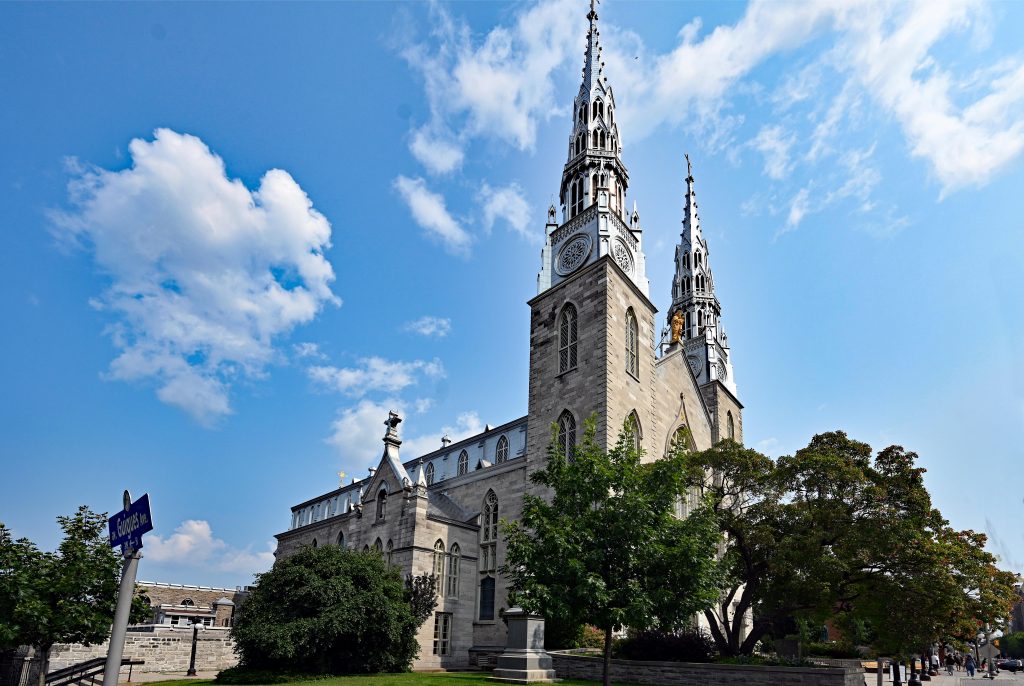
Twin spires, intricate woodwork, and a dazzling vaulted ceiling make it a spiritual and architectural gem. Still an active place of worship, it also serves as a concert venue and a focal point of the Catholic community in Ottawa.
8. Former Ottawa Teachers’ College
A few blocks west lies the former Ottawa Teachers’ College, built in 1875 in Second Empire style. Its mansard roof and symmetrical stone façade typify the educational architecture of the period.

Now part of the University of Ottawa’s Faculty of Education, the building reflects the city’s evolution from a colonial outpost to a center of learning and innovation.
9. Sparks Street
Looping back south, we walk along Sparks Street, one of Canada’s first pedestrian malls, established in 1967. Originally laid out in the 19th century, this street has long been Ottawa’s commercial hub.

A mix of Beaux-Arts, Art Deco, and Modernist architecture lines the street, housing shops, eateries, and government buildings. While it’s struggled with foot traffic in recent years, revitalization projects are underway to restore its vibrancy.
10. ByWard Market
Our walk concludes in ByWard Market, founded by Lieutenant Colonel John By in 1826 as part of the canal project. One of Canada’s oldest public markets, it blends vernacular 19th-century commercial architecture with modern elements.
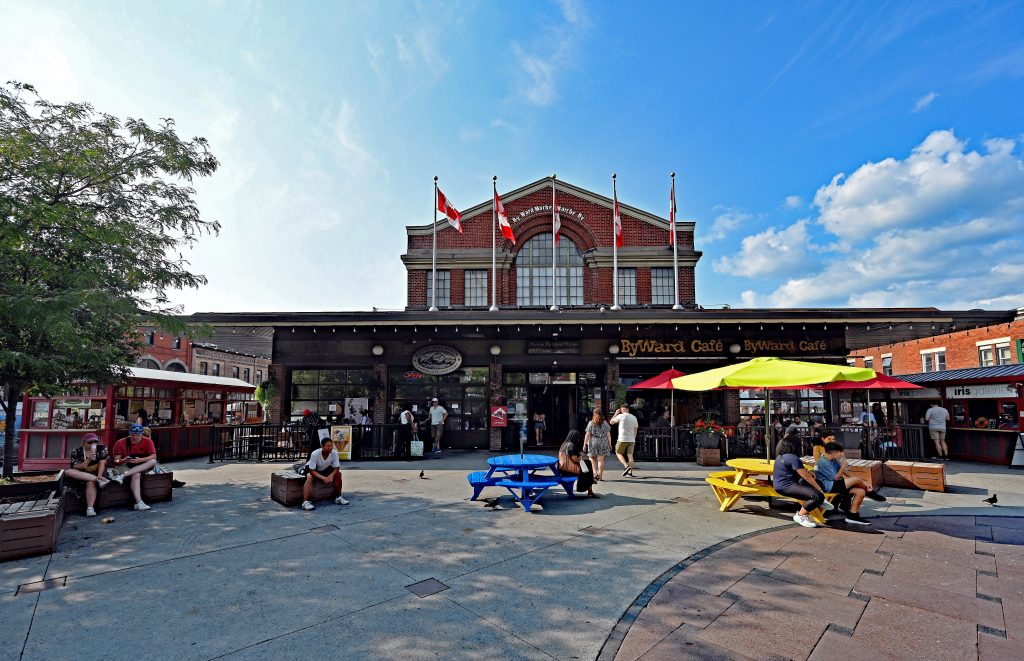
This district is alive with open-air vendors, boutique shops, galleries, pubs, and restaurants. The market remains a cultural and social epicenter, particularly lively in the summer months.
Final Thoughts
Ottawa is a city where old and new blend seamlessly. Walking through its core reveals a capital built with vision, resilience, and reverence for history. Each stop on this tour provides a window into Canada’s evolving identity—from colonial roots to a multicultural democracy grounded in tradition and innovation.